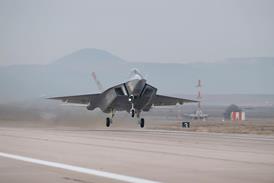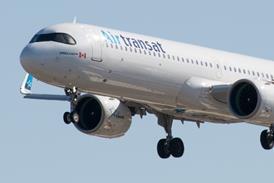Interstellar travel may still be in the realms of fantasy, but a NASA team is working on physics theories that might one day make it possible
guy norris / los angeles
Marc Millis, outgoing director of NASA's Breakthrough Propulsion Physics (BPP) project, likes to remind people that it does not take a rocket scientist to know that "space is really, really big!" So big, that only breakthroughs in physics of almost unimaginable magnitude will ever make interstellar travel possible.
Sheer mass interest in the concept of interstellar propulsion acts both for and against the BPP, says Millis. "It's definitely a double-edged sword. It may distort things and make it hard to stay objective, but it eases finding sources of funding."
Millis has harnessed the positive forces behind the BPP while trying to minimise the less desirable but inevitable "lunatic fringe", as he calls it. Since establishing the BPP in 1996 and legitimising the search for propulsion breakthroughs that are more reminiscent of Star Trek than the relatively pedestrian nuclear engine technology of the sci-fi movie 2001: A Space Odyssey, Millis has steered the BPP towards real targets. He has also fought hard to protect the project's image, which he admits is vulnerable to becoming "tainted" by sceptics.
Although he admits that he "doesn't really expect to see any of the breakthroughs made soon, if at all," Millis quickly adds that bringing scientific discipline to the search is as important as the search itself. He quotes Thomas Edison as the classic example behind the BPP's philosophy: "I speak without exaggeration when I say I have constructed 3,000 different theories in connection with the electric light, yet in only two cases did my experiments prove the truth of my theory."
Since putting Star Trek-like propulsion goals on the scientific map, the BPP plan has already begun to change although its three basic goals remain intact: breakthroughs in space transportation physics to find propulsion that requires no propellant mass; propulsion that attains the maximum transit speeds physically possible; and breakthrough methods of energy production to power such devices. The BPP charter assumes that, because these targets are "presumably far from fruition, a special emphasis is to identify affordable, near-term and credible research that could make progress toward these propulsion goals".
After opening for business under the sponsorship of NASA's Marshall Space Flight Center's advanced space transportation program, the Glenn Research Center-managed project is now establishing a research consortium. Administered by the Ohio Aerospace Institute, the consortium will be the go-between for universities, industry and the complex administrative functions needed to manage the increasingly international participants.
The consortium is still being put together, but will consist of an advisory council to enable member participation. The consortium will conduct surveys, solicitations and "prioritisation of candidate research, and maintain an electronic database of research proposals and results".
Millis believes the consortium will provide a balance for research which is "chipping away, bit by bit, at the various parts of this huge problem". He believes it will help prevent the BPP from becoming weighed too far in the direction of either more eclectic, academically-based pure scientific research, or falling in line with the wishes of more mainstream, industrial-based research. Under its revised plan, the consortium should issue a call for research proposals "within a couple of months", says Millis, who in July was succeeded by incoming BPP project manager Peter Ouzts. The consortium is due to issue formal research solicitations every other year.
In the midst of all this reorganisation and research, Millis is quick to remind would-be BPP participants of the fundamental challenges. In terms of speed and distance, he explains the problems by using an analogy: assuming the Sun was the same size as a 15mm-diameter marble, the distance from the Sun to the Earth (one "astronomical unit") would be around 1.2m. On this scale, the closest neighbouring star is about 360km away. If it takes eight minutes for light to travel between the Sun and the Earth, that star is 4.3 light years away.
Based on the speed of the Apollo spacecraft, which took three days to reach the moon, it would take more than 900,000 years to cover this distance. Even if the 59,200km/h (37,000mph) speed of the Voyager spacecraft were attained, the journey would still take 80,000 years.
Next come the twin problems of mass and energy. Although less obvious than the need for speed, these factors are just as critical. Mass is directly linked to propellant. Using current technology, a rocket - even a conceptual fusion or fission one - would require an enormous volume of fuel to make the journey. Millis estimates that to propel a Space Shuttle-size payload to the nearest star using a fission rocket would require 1 billion supertanker-sized tanks of fuel. Even a fusion-powered rocket would need 1,000 supertanker-sized tanks.
NASA's BPP has set hypothetical mission goals to further define the breakthrough requirements. These reveal that the only way to tackle the issue of mass is to discover fundamentally new ways of creating motion, possibly by manipulating inertia, gravity or by other interactions between matter, fields and space-time. The speed problem requires new means to move a vehicle at or near the actual maximum speed limit for motion through space. Alternatively, the vehicle could be moved through the motion of space-time itself (possibly circumventing the light speed limit) by using "warp drives" or even wormholes. The energy issue requires new modes of onboard energy generation to power these devices.
A long list of potential experiments has been drawn up, some of which have already begun in the BPP project's first phase. Most cover a realm of phenomena only hinted at by recent scientific advances, such as the intriguing suggestion from recent experiments and quantum theory that space may contain enormous levels of vacuum electromagnetic energy. Experiments are probing theories that this vacuum energy could be used as an energy source, or a propulsive reaction mass for space travel. Other new theories suggest that gravity and inertia themselves could be electromagnetic effects related to this vacuum energy.
From these origins, significant NASA-backed investigations are emerging into that "holy grail" of potential propulsion sources, gravity manipulation or anti-gravity. Sparked by the same set of vacuum energy theories, and by knowledge from the theory of general relativity that gravity, electromagnetism and space-time are inter-related, investigations have started into ideas that gravitational or inertial forces can be created or modified using electromagnetism.
Millis says theories have also emerged from general relativity about the nature of space-time. These suggest that the light-speed barrier, as described by Einstein's special relativity theory, might be circumvented by altering space-time itself.
So the search is on for clues to the existence of "warp drive" and scientific definition of "wormholes". The former, epitomised to recent generations by Star Trek, theoretically involves expansion and contraction of space-time to propel a region of space-time faster than light (superluminal). A "wormhole" is a potential shortcut created through space-time where a region of space-time is warped to create a shorter path between the two points. Another potential superluminal propulsive effect being investigated is "quantum tunnelling" - the travel of photons at an apparent 1.7 times the speed of light when tunnelling across a photonic band-gap barrier in an experiment in the early 1990s.
Under the BPP's initial six-year road map, the results of the first phase experiments, including the latest to be solicited later this year, will feed into an overall project assessment review tentatively set for 2003. This will set the stage for the third set of research solicitations in 2004, with a fourth set expected to be issued in 2006.
Under its 25-year road-map plan, the BPP expects the first five years to contribute directly to a basic understanding of the underlying physics. A second major phase, up to the project's eleventh year, will then focus on assessing the results' relevance to the overall goals of achieving interstellar travel. The last 16 years or so of the plan will be spent adapting selected effects towards applications, and perhaps the start of larger-scale experimentation.
No firm plan exists for the longer term, although Millis for one believes the search should have no time limits. "Even if it will not be in my lifetime or my children's lifetime, or even if it is impossible, I am firmly convinced that we as a society will gain far more trying to make such breakthroughs happen than if we didn't."
Source: Flight International




















